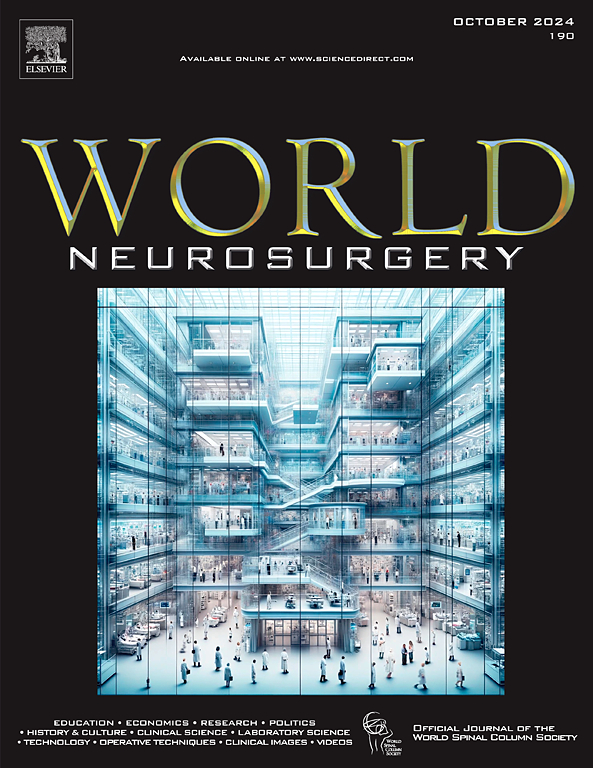动静脉畸形血管壁巨噬细胞浸润与血色素的相关性
IF 1.9
4区 医学
Q3 CLINICAL NEUROLOGY
引用次数: 0
摘要
导言:新血管血流增加所产生的高剪切应力会诱发内皮功能障碍,从而促进炎症循环,可能导致不稳定和脑动静脉畸形(AVM)破裂。经 CD68 鉴定的巨噬细胞是动静脉畸形病理学中的关键炎症成分。我们的目的是评估炎症与 AVM 血流和血色素的关系:这是一项对存档组织的回顾性研究。基线定量磁共振血管造影(QMRA)成像、无栓塞和显微手术切除史的成人患者(2002-2022 年)(17 人),包括破裂(9 人)和未破裂病例(8 人)。脑动静脉畸形切片用 CD68 染色,以量化血管壁巨噬细胞浸润情况,并用苏木精和伊红染色作为对照,以量化血色素。使用无创最佳血管分析(NOVA)对 QMRA 进行复查,并计算 AVM 流量。进行统计分析:结果:巨噬细胞浸润与患者的人口统计学特征、Spetzler-Martin分级、口才、静脉狭窄、瘤巢紧密度、体积和AVM流量之间无明显差异。血管壁巨噬细胞浸润与确诊 AVM 破裂的患者呈正相关(163.8 +/- 46.7 vs. 101.3 +/-49.4,p=0.017)。血管壁巨噬细胞浸润的增加与较高的血色素等级呈正相关(p=0.023),4 级血色素除外。静脉异常与巨噬细胞浸润呈负相关(p=0.035):这些发现表明 AVM 血管壁炎症、血色素和出血表现之间存在一定关系。有必要进行样本量更大的进一步研究,以了解血液动力学改变、血色素沉积和 AVM 血管壁炎症的作用。本文章由计算机程序翻译,如有差异,请以英文原文为准。

The Correlation of Vessel Wall Macrophage Infiltration With Hemosiderin in Arteriovenous Malformations
Background
Endothelial dysfunction, induced by high shear stress from increased nidal blood flow, may promote a cycle of inflammation, possibly leading to instability and cerebral arteriovenous malformations (AVMs) rupture. Macrophages, identified with Cluster of Differentiation 68, are key inflammatory components in AVM pathology. We aim to evaluate the relationship of inflammation with AVM flow and hemosiderin.
Methods
This is a retrospective study of archived tissue. Adult patients (2002–2022) with baseline quantitative magnetic resonance angiography imaging, no embolization, and history of microsurgical resection (n = 17), with both ruptured (n = 9) and unruptured cases (n = 8). Brain AVM sections were stained with Cluster of Differentiation 68 to quantify vessel wall macrophage infiltration and hematoxylin and eosin stain as a control and to quantify hemosiderin. Quantitative magnetic resonance angiography with noninvasive optimal vessel analysis was reviewed, and AVM flow was calculated. Statistical analyses were performed.
Results
There were no significant differences among macrophage infiltration and patient demographics, Spetzler-Martin grade, eloquence, venous stenosis, nidus compactness, volume, and AVM flow. Vessel wall macrophage infiltration positively correlated with patients who presented with confirmed AVM rupture (163.8 ± 46.7 vs. 101.3 ± 49.4, P = 0.017). Increases in vessel wall macrophage infiltration were found to positively correlate with higher grades of hemosiderin (P = 0.023), except for grade 4 hemosiderin. Venous anomaly showed a negative association with macrophage infiltration (P = 0.035).
Conclusions
These findings suggest a relationship among AVM vessel wall inflammation, hemosiderin, and hemorrhage presentation. Further investigations with larger sample sizes are warranted to understand the role of altered hemodynamics, hemosiderin deposition, and inflammation in AVM vessel walls.
求助全文
通过发布文献求助,成功后即可免费获取论文全文。
去求助
来源期刊

World neurosurgery
CLINICAL NEUROLOGY-SURGERY
CiteScore
3.90
自引率
15.00%
发文量
1765
审稿时长
47 days
期刊介绍:
World Neurosurgery has an open access mirror journal World Neurosurgery: X, sharing the same aims and scope, editorial team, submission system and rigorous peer review.
The journal''s mission is to:
-To provide a first-class international forum and a 2-way conduit for dialogue that is relevant to neurosurgeons and providers who care for neurosurgery patients. The categories of the exchanged information include clinical and basic science, as well as global information that provide social, political, educational, economic, cultural or societal insights and knowledge that are of significance and relevance to worldwide neurosurgery patient care.
-To act as a primary intellectual catalyst for the stimulation of creativity, the creation of new knowledge, and the enhancement of quality neurosurgical care worldwide.
-To provide a forum for communication that enriches the lives of all neurosurgeons and their colleagues; and, in so doing, enriches the lives of their patients.
Topics to be addressed in World Neurosurgery include: EDUCATION, ECONOMICS, RESEARCH, POLITICS, HISTORY, CULTURE, CLINICAL SCIENCE, LABORATORY SCIENCE, TECHNOLOGY, OPERATIVE TECHNIQUES, CLINICAL IMAGES, VIDEOS
 求助内容:
求助内容: 应助结果提醒方式:
应助结果提醒方式:


